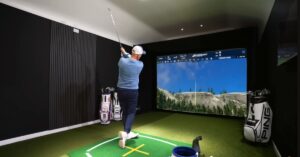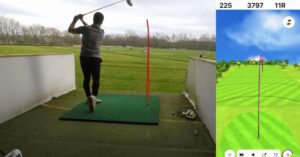How Golf Simulators Work for Realistic Play?
Golf simulators have revolutionized the way enthusiasts practice and enjoy the game. By replicating real-world golf experiences indoors, these cutting-edge devices offer a unique combination of entertainment and training benefits.
In this article, we’ll explore the technology behind golf simulators, delving into the intricacies of their workings and the various components that come together to create an immersive golfing experience.
Key Components of a Golf Simulator
Before we dive into how golf simulators work, it’s essential to understand their primary components.
These devices typically include a launch monitor, simulation software, and a projection screen with a hitting mat. Let’s take a closer look at each of these elements.
Launch Monitor
A launch monitor is the heart of any golf simulator. Using infrared sensors or radar technology, it tracks critical metrics, such as ball speed, launch angle, and spin rate.
The launch monitor provides valuable insights into the player’s swing and ball flight by capturing this data.
Simulation Software
Simulation software plays a pivotal role in replicating the golf course experience.
With accurate course mapping, realistic graphics, and advanced physics, the software helps bring the game to life on the projection screen, allowing players to practice on virtual versions of famous courses worldwide.
Projection Screen and Hitting Mat
The projection screen and hitting mat work together to provide a realistic environment for players to practice their shots.
Made from durable materials, these components are designed to withstand the impact of golf balls while offering multi-dimensional surfaces to mimic different types of terrain found on a golf course.
How do Golf Simulators Work? A Step-by-Step Guide
Now that we’ve covered the key components let’s walk through how a golf simulator translates your swing into a virtual shot.
We’ll look at the player’s swing and impact, data collection and analysis, shot outcome simulation and display, and performance feedback and improvement.
The Player’s Swing and Impact
The launch monitor captures essential data points as a golfer swings and strikes the ball. This information is then fed into the simulation software for processing.
Data Collection and Analysis
The simulation software analyzes the data collected by the launch monitor, using sophisticated algorithms to determine the ball’s trajectory, distance, and other relevant variables.
Simulation and Display of Shot Outcome
The software generates a visual representation of the shot on the projection screen based on the analyzed data.
Players can observe the outcome of their swing, including the ball’s path and final resting position on the virtual course.
Performance Feedback and Improvement
Golf simulators provide instant feedback, enabling players to review their shots and adjust for improvement.
With detailed statistics and analysis, golfers can focus on specific aspects of their game and develop targeted practice routines.
Types of Golf Simulators Based on Performance
Golf simulators come in various options to suit various needs and budgets. This section will explore the differences between entry-level, mid-range, and high-end simulators, helping you decide which one is right for you.
Entry-Level Simulators
Ideal for casual golfers and beginners, entry-level golf simulators offer a more affordable way to experience golf simulation.
While these simulators may not have the most advanced technology or sophisticated features, they still provide a fun and engaging experience.
Entry-level simulators typically use basic launch monitor technology and offer a limited selection of courses.
However, they can be an excellent starting point for those looking to improve their skills or have a good time without breaking the bank.
Mid-Range Simulators
Mid-range golf simulators strike a balance between affordability and performance.
They often come equipped with more advanced launch monitors, providing accurate ball data and a more extensive range of simulated courses.
Additionally, mid-range simulators usually have better graphics and more realistic course environments than their entry-level counterparts.
These simulators are perfect for avid golfers who want to enhance their skills and enjoy a more immersive experience without investing in top-of-the-line equipment.
High-End Simulators
Designed for the most discerning golfers and professionals, high-end golf simulators offer unparalleled accuracy and realism.
They use state-of-the-art technology, such as high-speed cameras or advanced radar systems, to capture precise ball data and provide comprehensive swing analysis.
High-end simulators also feature top-notch graphics, realistic course environments, and a vast selection of world-famous courses.
While these simulators come with a higher price tag, they deliver an unmatched golf simulation experience, making them the top choice for serious players and dedicated training facilities.
Maximizing Your Golf Simulator Experience
To truly reap the benefits of your golf simulator, it’s crucial to optimize its usage.
This section will discuss setting up and calibrating your simulator, incorporating training tips and drills, and embracing the entertainment and social aspects to enhance your overall experience.
Proper Setup and Calibration
Setting up your golf simulator correctly is the first step toward a seamless experience.
Ensure you allocate sufficient space for the hitting area, projector, screen, and additional equipment.
Follow the manufacturer’s guidelines for installation, and pay attention to the distance between the launch monitor and the hitting area.
Regularly calibrate your system to maintain accurate data tracking and simulation.
Training Tips and Drills
Golf simulators offer a plethora of training options to improve your game. Begin by focusing on areas of your game that need improvement, such as driving, chipping, or putting.
Use the simulator’s data feedback to identify weaknesses in your swing and make necessary adjustments.
Many simulation software programs also include built-in training drills and exercises to help you practice various skills and techniques.
Set goals, track your progress, and watch your performance improve.
Incorporating Entertainment and Social Aspects
While golf simulators are primarily designed for training, they offer an exciting and interactive entertainment platform.
Invite friends and family to enjoy a virtual round of golf or compete in multiplayer mode.
Many simulators feature game modes, such as closest-to-the-pin or longest-drive contests, which can add a fun and competitive element to your sessions.
Embrace the social aspects of golf simulators to create memorable experiences with your loved ones.
FAQs
How accurate are golf simulators?
The accuracy of a golf simulator depends on the quality of its components and calibration.
High-end simulators with advanced tracking technology and well-maintained software can provide remarkably accurate results.
Can a golf simulator improve my game?
Yes, golf simulators can help you improve your game by providing detailed data analysis of your swing, allowing you to identify and correct weaknesses.
Many simulators also offer built-in training drills and exercises to practice specific skills.
How much space do I need for a golf simulator?
The space required for a golf simulator depends on the model and your personal preferences.
Generally, you will need a room with a minimum ceiling height of 9-10 feet and an area of at least 12-15 feet wide and 15-20 feet deep to accommodate the hitting zone, projector, and screen.
How much does a golf simulator cost?
Golf simulators vary in price based on features, quality, and brand. Entry-level systems can start from around $2,000, while high-end simulators can cost upwards of $50,000 or more.
Can I use my own clubs and golf balls in a simulator?
Yes, most golf simulators are designed to work with your own clubs and golf balls.
However, some simulators may require unique golf balls with tracking markers or use foam balls for specific training.
Conclusion
Players will enjoy increasingly realistic and immersive experiences as golf simulator technology advances.
By understanding the intricacies of these systems and maximizing their usage, golfers can enhance their skills and enjoy the sport in a whole new way.
Embrace the future of golf and unlock your potential with the help of these incredible devices.






